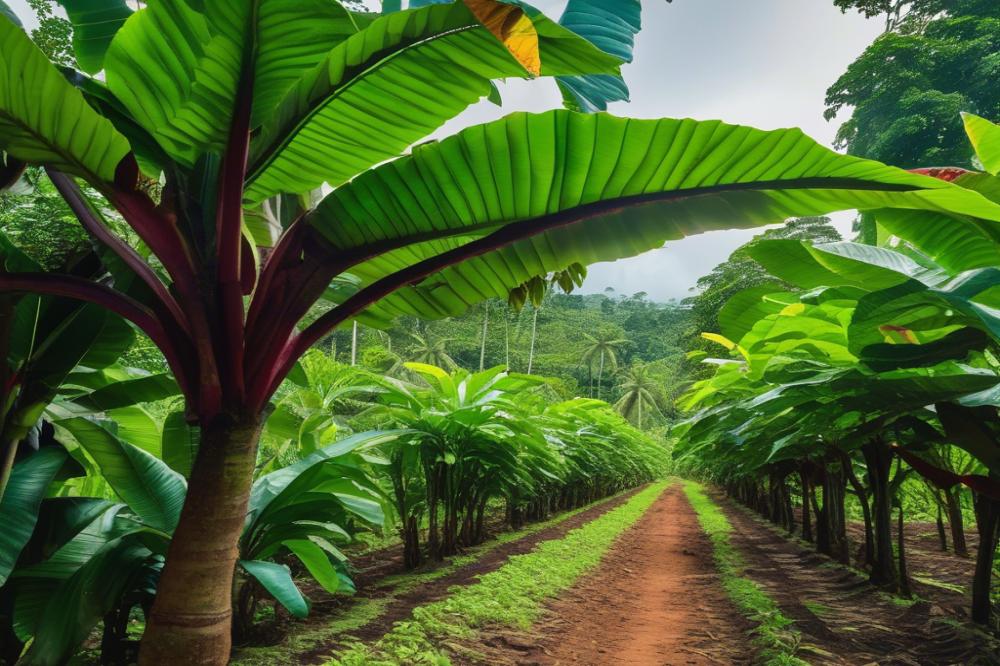Importance of climate-resilient cocoa in the Chocolate Industry
The chocolate industry relies heavily on cocoa, making its sustainability crucial. climate change poses significant threats to cocoa farming. Rising temperatures and erratic rainfall patterns create challenges for cocoa producers worldwide. This crisis emphasizes the necessity of developing climate-resilient cocoa varieties. By adapting farming practices, farmers can combat the adverse effects of climate change on their crops.
Farmers are increasingly recognizing the importance of sustainable agriculture. Implementing strategies like agroforestry can improve soil health while promoting biodiversity. Crop diversity is vital for enhancing resilience against diseases and pests. Many cocoa varieties exhibit traits that allow them to withstand changing climate conditions. This innovation in cocoa production leads to potential yield improvement.
Food security intertwines with cocoa farming. As the demand for chocolate grows, so does the need for stable cocoa production. By adopting climate-resilient cocoa varieties, farmers can increase their chances of success in the face of climate uncertainty. Environmental sustainability also benefits from these adaptations, ensuring a brighter future for both farmers and the planet.
The cocoa industry must adapt to survive. Innovations are emerging, but they require support from stakeholders at all levels. Collaboration among scientists, farmers, and businesses is essential to accelerate progress. By investing in resilient crops, we create a sustainable path forward. Unlocking the potential of climate-resilient varieties will not only help farmers but also protect the chocolate lovers who enjoy their unique creations.
Understanding Climate-Resilient Cocoa

Climate-resilient cocoa varieties are bred to thrive under challenging conditions caused by climate change. These plants show strong resistance to diseases, pests, and environmental stressors. Characteristics include drought tolerance, heat resistance, and the ability to adapt to variable rainfall patterns. By developing these unique cocoa plants, farmers can achieve better yields even in extreme weather.
The relationship between these cocoa plants and sustainable agriculture is vital. Practices that emphasize environmental sustainability help farmers adapt to climate change. When farmers grow resilient cocoa, they promote healthier ecosystems. Agroforestry techniques enhance biodiversity and create a more stable farming environment. These systems can support food security by providing consistent harvests despite shifting climates.
Crop diversity plays a crucial role in enhancing resilience. By planting various cocoa varieties alongside other crops, farmers buffer their land against the impacts of climate change. This approach reduces risks tied to extreme weather events. It also nurtures soil health and supports the local ecosystem. A diverse planting strategy protects farmers from the economic fallout of losing a single crop.
In the cocoa industry, yielding improvements translate to better profits for growers. Farmers who adapt to climate challenges with diverse crops can sustain their livelihoods. Investing in resilient cocoa not only helps farmers grow but contributes to a sustainable future. Families and communities benefit from this progress. Together, these efforts create a more secure food environment and improve quality of life.
The Role of Farmer Adaptation

Farmers play a crucial role in the cocoa industry, especially when it comes to adapting to climate change. Many are embracing climate-resilient cocoa varieties. These innovative choices help combat the adverse effects of shifting weather patterns and pests. Adapting farming practices is essential for their survival. It’s not just about planting different seeds; it’s about creating a new approach. Sustainable agriculture is key for these growers.
One prominent case study comes from West Africa. Farmers there began planting hybrid cocoa varieties that are more tolerant of drought. Surprisingly, they saw an increase in yield. This simple shift has made a significant impact on food security in their communities. Their success shows others the potential of making similar adjustments in their own farms.
Another inspiring example can be found in Indonesia. Farmers have adopted agroforestry systems, integrating cocoa with other crops. This strategy not only enhances crop diversity but also improves soil health. The result is impressive—higher productivity and increased resistance to climate stress. More farms are exploring this possibility, recognizing its benefits.
Modern science has provided valuable tools for these farmers. Yet, traditional knowledge remains important. Local farmers understand their land and climate better than anyone. Combining these two approaches leads to better outcomes. This blend of ancient wisdom and new techniques empowers growers to make informed decisions.
Ultimately, farmer adaptation drives yield improvement. Cocoa varieties that withstand climate challenges are vital for the future. Greater resilience helps ensure sustainable practices. As farmers continue to innovate, the entire cocoa industry stands to gain. Protecting the environment while producing more cocoa is a win-win situation.
Agroforestry and Environmental Sustainability

Agroforestry systems are revolutionizing cocoa production. They combine agriculture and forestry in a way that enhances overall farming practices. These systems involve the planting of shade trees with cocoa crops. Such an approach promotes sustainable agriculture and allows for greater crop diversity.
The role of shade trees cannot be overstated. They provide essential cover that protects cocoa plants from rising temperatures caused by climate change. These trees create a cooler microclimate for the cocoa varieties, which helps maintain optimal growing conditions. This is especially important as climate conditions become more unpredictable.
In addition to cooling effects, shade trees support biodiversity. A diverse ecosystem can attract beneficial insects and wildlife, which helps in natural pest control. Consequently, farmers adapt their practices to work in harmony with the environment, leading to healthier crops and more resilient farming systems.
Soil health also benefits from agroforestry. Trees improve soil structure and enhance nutrient cycling. Their root systems prevent erosion and promote water retention, which is vital for cocoa crops. Healthy soil can lead to yield improvement, directly affecting the productivity of cocoa farms.
Beyond individual farms, agroforestry impacts the cocoa industry at large. By practicing these sustainable methods, farmers contribute to broader goals like food security. Sustainable cocoa production methods can alleviate some pressures faced by the environment. The cocoa industry stands to gain from adopting these approaches, creating a more secure future for communities.
Food Security and the Cocoa Industry
The cocoa industry plays a vital role in food security. As climate change disrupts traditional farming methods, new challenges arise for farmers. Climate-resilient cocoa varieties stand out as a significant solution. These varieties adapt to changing weather patterns, which is crucial for the future of cocoa farming. They offer a way to maintain and even boost production levels in a warming world.
Many communities depend on cocoa for their livelihood. The rise in temperatures and shifting rainfall can threaten these essential crops. Farmers need options. Crop diversity is key here. When farmers grow a variety of resilient cocoa types, they better withstand environmental pressures. Increased diversity leads to better stability, safeguarding not just incomes but also local food security.
Aggressive efforts are underway to promote sustainable agriculture practices within the cocoa sector. Organizations worldwide recognize the urgency of climate adaptation. Partnerships between governments, NGOs, and the cocoa industry are growing. These collaborations focus on training farmers to adopt effective practices. They emphasize agroforestry as a beneficial method for improving yield. This approach not only provides shade for cocoa trees but also enhances soil quality.
Numerous initiatives aim to support farmer adaptation. These programs provide resources and knowledge to help farmers transition to new varieties. The cocoa industry is beginning to take active steps towards environmental sustainability. Investment in research plays a crucial role, with scientists developing better cocoa varieties to combat climate-related issues. Furthermore, sharing information within communities is critical for improving agricultural practices.
By recognizing that climate resilience is essential, the cocoa sector sets the stage for a brighter future. Strengthening production through robust initiatives can lead to greater food security. Collaboration and sustainable actions pave the way forward in the face of mounting challenges. This not only secures livelihoods but also feeds communities around the globe.
Future Trends and Innovations
Emerging technologies are shaping the future of cocoa production. Scientists are focused on developing varieties that can survive harsh climate conditions. This work involves sophisticated genetic engineering and selective breeding programs. By combining traits from different cocoa varieties, researchers aim to create plants that withstand drought, pests, and diseases.
Farmers have a crucial role in adapting to changing weather patterns. They need access to improved seedlings that thrive under new conditions. By investing in crop diversity, they can secure their livelihoods and increase yield. These innovations will not only strengthen farmer adaptation but also contribute to the cocoa industry’s overall resilience.
The practice of agroforestry offers another valuable avenue. Integrating cocoa trees with other crops enhances environmental sustainability. This method promotes biodiversity and provides alternative income streams for farmers. Such practices can lead to improved food security in their communities.
Looking ahead, the potential for collaboration among researchers, farmers, and industry leaders is significant. With shared knowledge, the chocolate industry can better combat the challenges posed by climate change. Adoption of these resilient varieties will also add value to the global market. As consumers become more aware of sustainability, demand for responsibly sourced cocoa is likely to rise.
Incorporating climate-resilient cocoa into farming practices can lead to a brighter future. Improved yield not only benefits farmers but also consumers. Chocolate lovers may enjoy products made from sustainably grown cocoa, knowing they support both the planet and local economies. Transitioning to more innovative and resilient practices ultimately reinforces the sustainability goals of the entire cocoa sector.
Final Thoughts on the Future of Cocoa Production
The transformative impact of climate-resilient cocoa on production is becoming increasingly clear. Farmers who adopt these varieties show greater crop yields despite rising temperatures and erratic rainfall patterns. This shift not only helps their farms but also supports entire communities that rely on cocoa. With climate change posing serious risks, the resilience of crops can stabilize the livelihoods of those in the industry.
Embracing sustainable agriculture is vital. It allows us to tackle environmental challenges while meeting the global demand for cocoa. Commitment to practices that are environmentally sound will indubitably make a difference. Stakeholders in the cocoa supply chain play a crucial role in promoting these methods.
Everyone must recognize that our collective actions impact future generations. Business leaders, farmers, and consumers should all champion sustainable practices. Together, we can build a robust cocoa industry that thrives and adapts to changing conditions. It’s time to act for a better, more sustainable future for cocoa.



